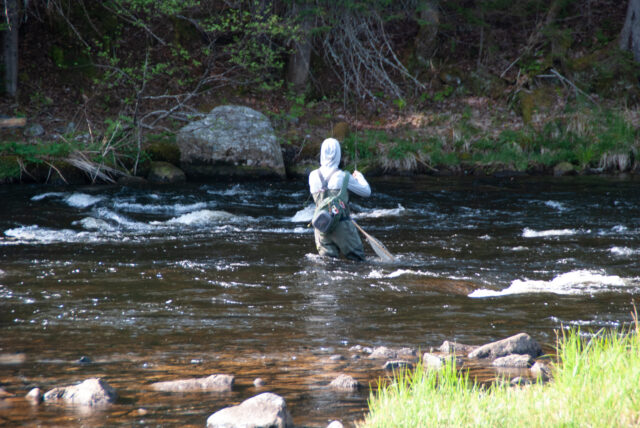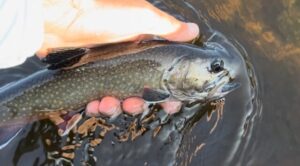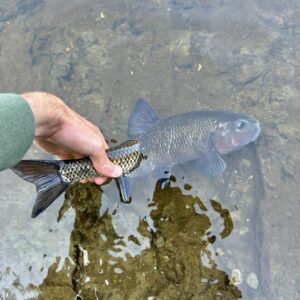
If you were forced to boil down the fishing Maine’s Rangeley Region into just three words, it would likely be these: big brook trout.
And in truth, that is the region’s claim-to-fame. The western Maine mountains are one of the last areas in the country to harbor wild, native squaretails that exceed 20 inches. In the spring and fall, diehard anglers from around the country flock to Rangeley for their chance to hook into one of these brutes.
In all that admiration for the brook trout, however, is lost the myriad of other angling opportunities the region provides. Fishing in Rangeley is far more than swinging traditional smelt streamers for a couple of months each year; it is nymphing through pocket water, fishing the evening hatch on a stillwater, and chucking outsized flies for undervalued species. There is no better time to experience that variety than right now, and thankfully I was right in the middle of it during Memorial Day Weekend.
Below is a rough itinerary of some of the places I visited over the weekend. Each spot has its own unique character, and you’re sure to find plenty of variety among species and water types as you hop from location to location. Use these as a starting guide, and have fun expanding your arsenal as you explore the woods and waters of the Rangeley region.
Little Kennebago Lake

No adventure in Maine’s north country is complete without a stillwater trip. Maine is lucky to have approximately 580 State Heritage Fish Waters, ponds and lakes containing healthy populations of wild, native brook trout and arctic charr. The Rangeley area is home to a number of such waters, each one very unique in its own right.
Little Kennebago Lake is a great starting point for local stillwater options. Unlike nearby Kennebago Lake, access is public and fairly easy, requiring about a 10-mile ride on gravel roads. I always like to plan my stillwater fishing for the day in my trip with the best weather, meaning the least wind and the lowest chance of precipitation. Unfortunately, on a nice day, especially on a weekend, you won’t be the only one enjoying the beauty of the lake and middle Kennebago River; however, it is easy to find solitude once on the water.

At 190 acres, the Little Kennebago is far from large, but it does help to have a watercraft to fish it. For those fishing from shore, the launch offers access to the middle portion of the Kennebago River, and a short hike will bring you to a shallow sand bar on the lake where small brook trout feed on emerging insects.
Thankfully there was no shortage of emerging insects over Memorial Day weekend. My grandfather graciously acted as my chauffeur, paddling me wherever a pod of rising fish appeared. We began in the shallows, where the trout were small but eager to take a soft hackle Hare’s Ear just beneath the surface. But as we worked our way further into the pond and into slightly deeper water, the average size increased and the action only picked up. The big fish of the day, maybe an 11-incher, came on a Wood Special fished in deeper water on a sinking line. It may not have been a monster, but a fish of that caliber anywhere else in the Lower 48 would be a trophy. This one was obviously a deep-water fish, with a racy physique and deep, crimson-tinged fins.

Magalloway River

The Magalloway likely occupies a space on every New England angler’s bucket list – and for good reason. The river provides consistent opportunities for some of Maine’s largest brook trout and landlocked salmon. But visitors must remember that it is still a tailwater, and a technical and heavily fished one at that. Difficult wading and whitewater releases later in the season only add to the challenge. A Swift River newbie shouldn’t go in thinking they’ll have lights-out success, and neither should a first timer on the Mag.
That’s not to scare anyone away from visiting this fantastic fishery. The lower river offers plenty of access points right off Route 16, each one perfect for a different tactic. This time I began closer to the dam, dredging the pocket water with a team of nymphs. I managed to draw a few strikes and promptly lose them, but when I broke off the flies to a snag, it was time for a change. By then the black flies had grown so unbearable I had to run back to the car to throw on a bug net and some nitrile gloves, protecting the last of my exposed skin.
Once I returned, I tied on a jig Deadly Empie Shiner, which has become a constant in my box throughout this season. I set my sights on a juicy piece of pocket water – only problem was, it was in the middle of the river. Wading over smooth, slippery boulders in the swift current, I nearly lost my footing with each step. After stumbling into position, I finally managed to fire off a cast. Pick up the slack, get in contact. One flick of the rod tip, then another.
On the third flick, BOOM! A solid take reverberated through the limber rod as the culprit, a hefty silver-sided salmon, launched itself through the air. The fish took off downstream, sending me scrambling over boulders and through pools (there must have been some serious luck at play to have kept me on my feet). I was elated to finally land the fish after numerous jumps and nerve-wracking runs. It likely went 15 or 16 inches, powerfully built from spending its whole life in the swift current.
Further downstream, where the water mellows a bit, fellow anglers were finding luck on dries. March browns and caddis were the hatches of the day, though I saw very few rises.

Kennebago River

The fishing on the Kennebago, especially in its lower reaches, is quite boom-or-bust. Early spring and fall bring runs of trophy trout and salmon, but the middle season – between mid-May and early-September – offers little in the way of salmonids. What it does offer, though, is the chance to catch unusually large members of a criminally-underrated species: the fallfish.
In the week leading up to Memorial Day, fallfish travel upstream from the lakes on a spawning migration. Anglers making the pilgrimage to these storied trout waters are often surprised when their first casts yield a fish – but not exactly the type they were hoping for. Over the years, I’ve come to appreciate fallfish for what they are: a true gamefish.

Though their appearance might not suggest it, fallfish are vicious predators. In years past, I’ve had great success catching them on large mouse patterns skated across the surface. This Memorial Day, the hot flies were a Wood Special fished on a sinking line and a conehead Slumpbuster. Oftentimes I was able to sight-fish, watching the fish move into the shallows and tossing my streamer just in front of them. My biggest of the weekend taped out at 18 inches – a beast by any standards.
If you are dead-set on catching a trout or salmon, it is still possible; just don’t go expecting any big ones this time of year. Fishing small dries through shallow riffles in the morning is your best bet.
Be advised that you will not be alone on the lower river. This stretch has become increasingly popular among swimmers, canoeists, bikers, and other recreationists. In my opinion, it is best fished on a rainy day, or a hot one when wet wading seems like an inviting option.
Rangeley River

The Rangeley is a great “last-chance” river if you’ve struggled to find fish in other spots. Most times of year, it offers the best chance at catching a brookie or salmon, though in late spring / summer most fish are in the six-to-eight-inch range. Unlike the other famous rivers in the area, the Rangeley is essentially an enlarged small stream from its creation at Rangeley Lake’s outlet until it reaches the slow waters of Mooselookmeguntic Lake.

Access to the river is easy, and the fish are willing. I can’t think of time I visited the river without at least a few rising fish. This year, the late evening mayfly hatch bordered on legendary, with rising trout and salmon gorging themselves on the large insects. The lower pool offered the technical dry fly fishing of all fly anglers’ dreams. The placid waters with their gentle cross-currents demanded a perfect drag-free drift with a realistic March Brown or Hendrickson dry. Perfect the presentation, though, and you were almost guaranteed a fish.
And of course, no Rangeley trip is complete without a few flies from the Rangeley Region Sports Shop, a sandwich at the Oquossoc Grocery (turkey avacado wrap is my personal favorite), and an ice cream cone at the Pine Tree Frosty. Enjoy your time in the North Woods, and try not to get carried away by the bugs.
Discover more from BlogFlyFish.com
Subscribe to get the latest posts sent to your email.

Don’t forget a visit to the Rangeley Outdoor Heritage Museum for a great break from the bugs! BTW you are correct about Fallfish being a hoot to catch. My PB is only 15″.
The Salmon runs in the Kennebago have been very light to non-existent in the past 6 years or so in the gated area, as have been the flows. No water, no fish!
Steve, great call on the Heritage Museum, always something new and interesting to explore there. Let’s hope for a good water year, but I expect we weren’t the only ones that found a new appreciation for native fallfish as the salmonid runs have declined.
Nice. My grandfather rebuilt the braiding machine in that mesuem and other such things with fly fishing. Harry Cary.
Ed Leonard used to come to my house regularly as I grew up with my grandparents in the same house. They call my pa the dean of steep bank pool actually. Don palmer and Richard Seacord we very close also. I’m actually on Rt 17 now, about to take a walk to the Rangeley river dam and see if I can get a few.